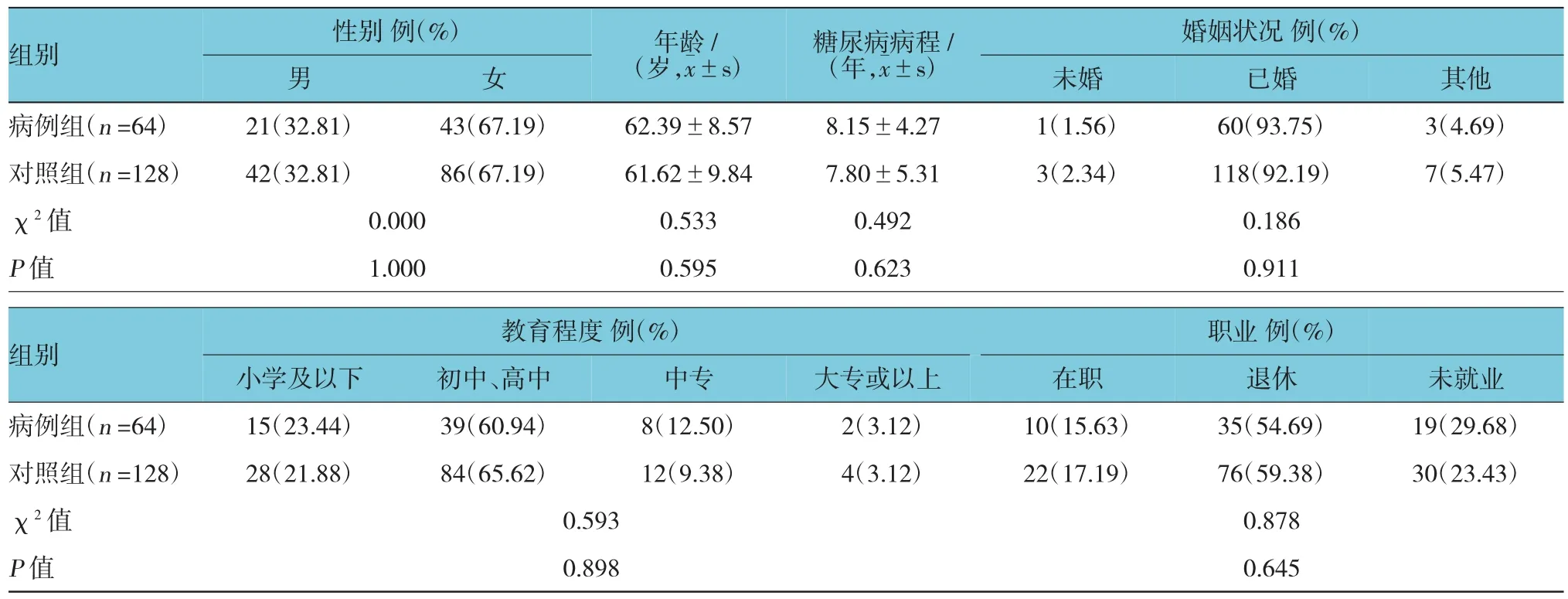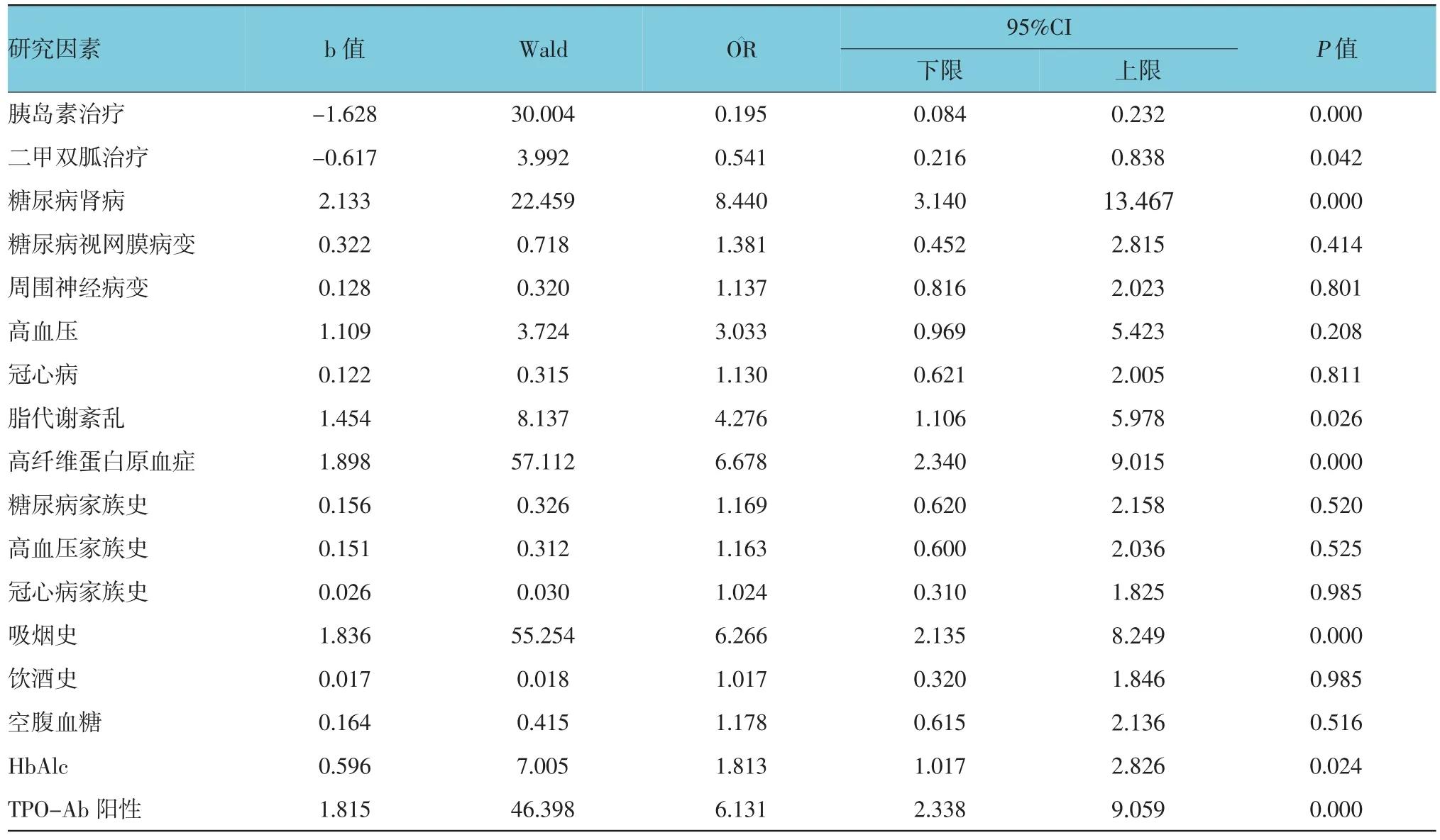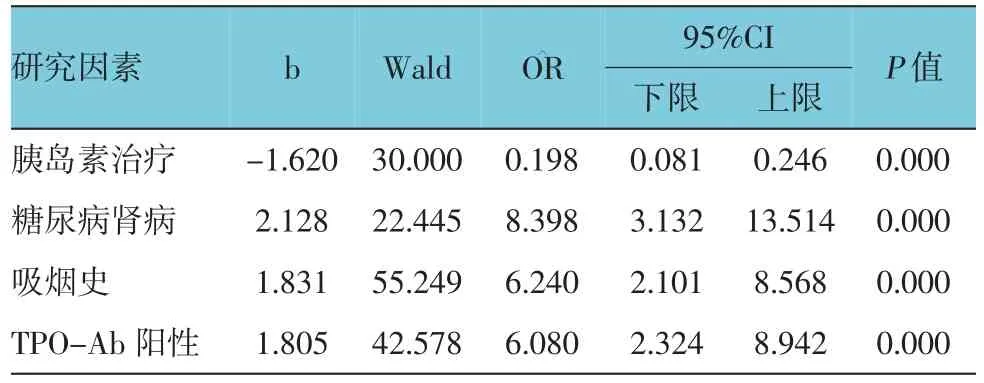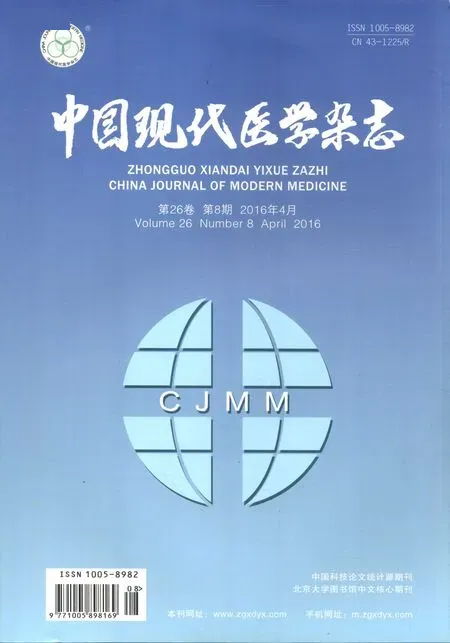2型糖尿病合并甲状腺功能减退相关危险因素的Logistic回归分析
姚静
(贵州省铜仁市人民医院内分泌科,贵州铜仁554300)
2型糖尿病合并甲状腺功能减退相关危险因素的Logistic回归分析
姚静
(贵州省铜仁市人民医院内分泌科,贵州铜仁554300)
摘要:目的探讨2型糖尿病合并甲状腺功能减退的相关危险因素。方法选取2013年1月-2015年1月于贵州省铜仁市人民医院内分泌科病房住院的2型糖尿病合并甲状腺功能减退患者64例作为病例组研究对象,随机抽取同期本院住院的2型糖尿病患者128例作为对照组研究对象,收集两组研究对象的临床资料,并进行相关危险因素的Logistic回归分析。结果单因素非条件Logistic回归分析发现:胰岛素治疗及二甲双胍治疗是2型糖尿病合并甲状腺功能减退的保护因素(=0.195、0.541,95%CI:0.084,0.232;0.216,0.838);糖尿病肾病、脂代谢紊乱、高纤维蛋白原血症、吸烟史、HbAlc高以及TPO-Ab阳性是2型糖尿病合并甲状腺功能减退的危险因素(=8.440、4.276、6.678、6.266、1.813、6.131,95%CI:3.140,13.467;1.106,5.978;2.340,9.015; 2.135,8.249;1.017,2.826;2.338,9.059);多因素非条件Logistic回归分析发现胰岛素治疗是2型糖尿病合并甲状腺功能减退的保护因素(=0.198,95%CI:0.081,0.246);糖尿病肾病、吸烟史、TPO-Ab阳性均是2型糖尿病合并甲状腺功能减退的危险因素(=8.398、6.240、6.080,95%CI:3.132,13.514;2.101,8.568;2.324,8.942)。结论胰岛素治疗、糖尿病肾病、吸烟史、TPO-Ab阳性均与2型糖尿病合并甲状腺功能减退有相关性,对于患有糖尿病肾病、有吸烟史和TPO-Ab阳性的2型糖尿病患者,应定期监测甲状腺功能。
关键词:2型糖尿病;甲状腺功能减退;危险因素;Logistic回归分析
随着经济社会的飞速发展,人民生活水平的提高,生活方式改变,再加上人口老龄化加剧,糖尿病患病率越来越高,已成为全球性重大公共卫生问题[1]。糖尿病和甲状腺功能异常均为内分泌异常疾病[2-3],糖尿病患者中2型糖尿病占90%以上[4],近年来,2型糖尿病患者的甲状腺功能状态越来越受到人们的关注,有研究[5]发现2型糖尿病患者的甲状腺功能异常患病率达到25.2%,而合并甲状腺功能减退的患病率达到18.9%,占甲状腺功能异常的70.0%以上,给社会带来了沉重的疾病负担。本研究通过探讨2型糖尿病患者合并甲状腺功能减退的相关危险因素,为临床治疗和预防提供理论依据。
1 资料与方法
1.1研究对象
选取2013年1月-2015年1月于贵州省铜仁市人民医院内分泌科病房住院的2型糖尿病合并甲状腺功能减退患者64例作为病例组研究对象。年龄30~75岁,糖尿病病程(8.15±4.27)年。按照病例和对照比例约为1:2的标准,随机抽取同期本院内分泌科病房住院的没有甲状腺疾病史且甲状腺功能正常、年龄30~75岁以及糖尿病病程为(7.80±5.31)年的2型糖尿病患者128例作为对照组研究对象。
1.2研究方法
采用病例对照的调查研究方法,收集研究对象的如下信息:
1.2.1一般人口学资料包括性别、年龄、婚姻状况、教育程度及职业等。
1.2.2糖尿病患者现病史包括糖尿病确诊时间、治疗情况(胰岛素、口服降糖药)、有无糖尿病肾病、糖尿病视网膜病变、周围神经病变、高血压、冠状动脉粥样硬化性心脏病(简称冠心病)、脂代谢紊乱及高纤维蛋白原血症等并发症。
1.2.3疾病家族史包括有无糖尿病家族史、高血压家族史及冠心病家族史等。
1.2.4行为生活方式包括有无吸烟史和饮酒史。
1.2.5实验室检查指标包括空腹血糖、糖化血红蛋白(HbAlc)、TG、TC、LDL-C、HDL-C、血浆纤维蛋白原(FIB)、FT4、FT3、甲状腺过氧化物酶抗体(TPO-Ab)及尿微量清蛋白。
1.3判定标准
糖尿病肾病:既往已经确诊为糖尿病肾病或者2型糖尿病患者住院期间连续2次24 h尿微量清蛋白≥30 mg/24 h,并已经排除了其他病因导致的肾脏损害、泌尿系统感染和血尿;脂代谢紊乱:TG>1.71 mmol/L,或者TC>5.70 mmol/L,或者LDL-C> 3.10 mmol/L,或者男性HDL-C<1.10 mmol/L、女性HDL-C<1.20 mmol/L;高纤维蛋白原血症:空腹血浆血浆FIB>4.00 g/L;TPO-Ab阳性:TPO-Ab>34 IU/ml。
1.4统计学方法
调查问卷数据采用Epi Data 3.0软件进行录入,核对无误以后采用SPSS 19.0统计软件包进行数据分析。计量资料采用均数±标准差(±s)表示,其比较采用Z检验;计数资料采用例数(%)表示,其比较采用χ2检验;对2型糖尿病合并甲状腺功能减退相关危险因素分析采用单因素和多因素非条件Logistic回归分析,单因素分析统计学检验水准取双侧α=0.2,选择单因素分析中P≤0.2的相关因素进入多因素非条件Logistic回归分析,采用逐步后退法(似然比),纳入模式标准0.05,剔除标准0.10,P<0.05为差异有统计学意义。
2 结果
2.1病例组与对照组的一般情况
本研究共纳入病例组患者64例,对照组128例,其中病例组男性21例,女性43例,平均年龄(62.39±8.57)岁,对照组男性42例,女性86例,平均年龄(61.62±9.84)岁。两组人群在性别、年龄、糖尿病病程、婚姻状况、教育程度及职业构成等方面比较差异均无统计学意义(P>0.05),由此可见选取的两组资料均衡性较好,具有可比性。见表1。
2.22型糖尿病合并甲状腺功能减退相关危险因素的单因素分析
本研究通过单因素非条件Logistic回归分析发现:①胰岛素治疗及二甲双胍治疗的2型糖尿病患者发生合并甲状腺功能减退的危险性比未进行胰岛素治疗及二甲双胍治疗的2型糖尿病患者低,胰岛素治疗及二甲双胍治疗是2型糖尿病合并甲状腺功能减退的保护因素(=0.195、0.541,95%CI:0.084,0.232;0.216,0.838);②糖尿病肾病、脂代谢紊乱和高纤维蛋白原血症的2型糖尿病患者发生合并甲状腺功能减退的危险性比无糖尿病肾病、脂代谢紊乱和高纤维蛋白原血症的2型糖尿病患者高,糖尿病肾病、脂代谢紊乱和高纤维蛋白原血症是2型糖尿病合并甲状腺功能减退的危险因素(= 8.440、4.276、6.678,95%CI:3.140,13.467;1.106,5.978;2.340,9.015);③行为生活方式:有吸烟史的2型糖尿病患者发生合并甲状腺功能减退的危险性比无吸烟史的2型糖尿病患者高,吸烟史是2型糖尿病合并甲状腺功能减退的危险因素2.135,8.249);④HbAlc:HbAlc高的2型糖尿病患者发生合并甲状腺功能减退的危险性比HbAlc低的2型糖尿病患者高,HbAlc高是2型糖尿病合并甲状腺功能减退的危险因素2.826);⑤TPO-Ab:TPO-Ab阳性的2型糖尿病患者发生合并甲状腺功能减退的危险性比TPO-Ab阴性的2型糖尿病患者高,TPO-Ab阳性是2型糖尿病合并甲状腺功能减退的危险因素CI:2.338,9.059)。见表2。

表1 病例组与对照组的一般资料比较

表2 2型糖尿病合并甲状腺功能减退相关危险因素的单因素分析
2.32型糖尿病合并甲状腺功能减退相关危险因素的多因素分析
本研究以2型糖尿病是否合并甲状腺功能减退作为因变量,将单因素非条件Logistic回归分析有意义的变量均作为自变量一起进入多因素非条件Logistic回归分析,研究发现胰岛素治疗是2型糖尿病合并甲状腺功能减退的保护因素(=0.198, 95%CI:0.081,0.246);糖尿病肾病、吸烟史和TPO-Ab阳性均是2型糖尿病合并甲状腺功能减退的危险因素(=8.398、6.240、6.080,95%CI:3.132,13.514; 2.101,8.568;2.324,8.942)。以上因素对2型糖尿病合并甲状腺功能减退发生的作用方向及大小与单因素分析结果类似。(见表3)。

表3 2型糖尿病合并甲状腺功能减退相关危险因素的多因素分析
3 讨论
本研究通过对2型糖尿病合并甲状腺功能减退的相关危险因素进行探讨,发现胰岛素治疗是2型糖尿病合并甲状腺功能减退的保护因素,糖尿病肾病、吸烟史和TPO-Ab阳性均是2型糖尿病合并甲状腺功能减退的危险因素。
3.1胰岛素治疗
目前对胰岛素治疗与2型糖尿病合并甲状腺功能减退的相关性结论不一致,Distiller等[6]发现胰岛素治疗是2型糖尿病合并甲状腺功能减退的危险因素,而Kim等[7]发现胰岛素治疗是2型糖尿病合并甲状腺功能减退的保护因素,本研究亦发现胰岛素治疗是2型糖尿病合并甲状腺功能减退的保护因素,鉴于目前胰岛素治疗与2型糖尿病合并甲状腺功能减退的相关性研究较少且结论不一致,有必要进行大样本量多中心的研究来探讨二者的相关性关系。
3.2糖尿病肾病
糖尿病肾病患者容易合并甲状腺功能减退,原因可能是:糖尿病肾病患者的肾小球基底膜受到损坏,导致大量清蛋白伴随尿液排泄,同时甲状腺激素也会伴随甲状腺结合球蛋白进入尿液而排泄掉,从而减少甲状腺素的合成,引起甲状腺功能减退的发生[8];而且糖尿病肾病患者尿液中T3和T4排泄量显著增加,也会引起患者机体内的甲状腺素水平降低,引起甲状腺功能减退的发生[9];此外,糖尿病合并甲状腺功能减退也可以加剧糖尿病肾病的发生发展[10]。本研究发现糖尿病肾病是2型糖尿病合并甲状腺功能减退的危险因素(=8.398,95%CI:3.132, 13.514),提示对2型糖尿病患者要定期监测甲状腺功能,做到早发现、早诊断和早治疗,降低糖尿病合并甲状腺功能减退及糖尿病肾病的发病率。
3.3吸烟史
目前吸烟与2型糖尿病合并甲状腺功能减退的相关性研究较少,本研究发现吸烟史是2型糖尿病合并甲状腺功能减退的危险因素(=6.240,95%CI: 2.101,8.568),原因可能是与吸烟可以干扰甲状腺激素合成并影响其功能发挥有关[11],所以对吸烟糖尿病患者要定期监测其甲状腺功能,早期发现异常并及时给予治疗。
3.4TPO-Ab
TPO-Ab是自身免疫性甲状腺疾病的标志性抗体,是导致甲状腺功能异常的重要因素,有大样本的调查研究[12]发现,TPO-Ab与甲状腺功能减退呈正相关,Karmisholt等[13]发现2型糖尿病合并甲状腺功能减退患者的TPO-Ab异常增高可以预测其会出现亚临床甲状腺功能减退,本研究发现TPO-Ab阳性是2型糖尿病合并甲状腺功能减退的危险因素6.080,95%CI:2.324,8.942),所以建议对TPO-Ab阳性的2型糖尿病患者定期监测其甲状腺功能。
综上所述,胰岛素治疗、糖尿病肾病、吸烟史及TPO-Ab阳性均与2型糖尿病合并甲状腺功能减退有相关性,对于患有糖尿病肾病、有吸烟史及TPO-Ab阳性的2型糖尿病患者,定期监测其甲状腺功能,发现异常并及时对症治疗,对于降低2型糖尿病合并甲状腺功能减退的发病率,提高患者的生活质量,减轻社会负担具有重要的临床意义。
参考文献:
[1] Erdim S, Ismail K, Serkan T, et al. Comparison of plasma and erythrocyte membrane fatty acid compositions in patients with end-stage renal disease and type 2 diabetes mellitus[J]. Chemistryand Physics of Lipids, 2014, 178(1): 11-17.
[2] Airin CRS, Frits H, Wouter TG, et al. Safety and usability evaluation of a web-based insulin self-titration system for patients with type 2 diabetes mellitus[J]. Artificial Intelligence in Medicine, 2013, 59(1): 23-31.
[3] Tank JC, Weiner DS, Jacquet R, et al. The effects of hypothyroidism on the proximal femoral physis in miniature swine [J]. Journal of Orthopaedic Research, 2013, 31(12): 1986-1991.
[4] Xu WJ, Zhang LG, Huang YH, et al. Fatty acid metabolic profiles and biomarker discovery for type 2 diabetes mellitus using graphical index of separation combined with principal component analysis and partial least squares-discriminant analysis[J]. Chemometrics and Intelligent Laboratory Systems, 2012, 118 (11): 173-179.
[5] Deetman PE, Kwakernaak AJ, Bakker SJL, et al. Low-normal free thyroxine confers decreased serum bilirubin in type 2 diabetes mellitus[J]. Thyroid: Official Journal of The American Thyroid Association, 2013, 23(11): 1367-1373.
[6] Distiller LA, Polakow ES, Joffe BI, et al. Type 2 diabetes mellitus and hypothyroidism: The possible influence of metformin therapy[J]. Diabetic Medicine: a Journal of the British Diabetic Association, 2014, 31(2): 172-175.
[7] Kim BY, Kim CH, Jung CH, et al. Association between subclinical hypothyroidism and severe diabetic retinopathy in Korean patients with type 2 diabetes[J]. Endocrine Journal, 2011, 58(12): 1065-1070.
[8] Gao ZH, Yuan RY, Li GP, et al. Comment on: "association between subclinical hypothyroidism and severe diabetic retinopathy in korean patients with type 2 diabetes"[J]. Endocrine Journal, 2011, 58 (12): 1105-1106.
[9] Wu MT, Huang SC, Chen YL, et al. Concurrent Hypothyroidism with IgA Nephropathy Presenting with Acute Heart and Oliguric Renal Failure[J]. Acta Nephrologica, 2012, 26(2): 100-103.
[10] Chen HS, Wu TE, Jap TS. Subclinical hypothyroidism is a risk factor for nephropathy and cardiovascular diseases in Type 2 diabetic patients[J]. Diabetic Medicine, 2007, 24(12): 1336-1344.
[11] Ittermann T, Thamm M, Schipf S, et al. Relationship of smoking and/or passive exposure to tobacco smoke on the association between serum thyrotropin and body mass index in large groups of adolescents and children[J] .Thyroid, 2013, 23(3): 262-268.
[12] Blatt AJ, Nakamoto JM, Kaufman HW, et al. National status of testing for hypothyroidism during pregnancy and postpartum[J]. The Journal of Clinical Endocrinology and Metabolism, 2012, 97 (3): 777-784.
[13] Karmisholt J, Andersen S, Laurberg P, et al. Variation in thyroid function in subclinical hypothyroidism: importance of clinical follow-up and therapy[J]. European Journal Of Endocrinology, 2011, 164(3): 317-323.
(张西倩编辑)
Logistic regression analysis of risk factors associated with type 2 diabetes mellitus combined with hypothyroidism
Jing Yao
(Department of Endocrinology, Tongren People's Hospital, Tongren, Guizhou 554300, China)
Abstract:Objective To investigate the related risk factors of type 2 diabetes mellitus combined with hypothyroidism. Methods From Jan 2013 to Jan 2015, 64 patients with type 2 diabetes mellitus combined with hypothyroidism in our hospital were selected as the case group, 128 patients with type 2 diabetes mellitus were randomly selected as the control group. The clinical data of the two groups were collected and analyzed by Logistic regression analysis. Results Single factor non conditional Logistic regression analysis showed that insulin therapy and metformin treatment were protective factors of type 2 diabetes mellitus with hypothyroidism(= 0.195, 0.541. 95% CI = 0.084-0.232, 0.216 -0.838 ). Diabetic nephropathy, lipid metabolism disorders, high fibrinogen, smoking history, high HbAlc and TPO-Ab positive were risk factors for type 2 diabetes mellitus combined with hypothyroidism(= 8.440, 4.276, 6.678, 6.266, 1.813, 6.131. 95% CI = 3.140-13.467, 1.106-5.978, 2.340-9.015, 2.135-8.249, 1.017-2.826, 2.338-9.059). Multiple factor non conditional Logistic regression analysis found that insulin therapy was a protective factor for type 2 diabetes mellitus with hypothyroidism (= 0.198, 95% CI = 0.081-0.246 ). Diabetic nephropathy, smoking history, and TPO-Ab positive were risk factors for type 2 diabetes mellitus combined with hypothyroidism (= 8.398, 6.240, 6.080. 95% CI = 3.132-13.514, 2.101-8.568, 2.324-8.942 ). Conclusionsbook=123,ebook=128Insulin therapy, diabetic nephropathy, smoking history, TPO-Ab positive are associated with type 2 diabetes mellitus combined with hypothyroidism. Type 2 diabetes with diabetes mellitus, smoking history, TPO-Ab positive should be regularly monitor their thyroid function.
Keywords:type 2 diabetes mellitus; hypothyroidism; risk factor; Logistic regression analysis
收稿日期:2016-01-20
文章编号:1005-8982(2016)08-0122-05
DOI:10.3969/j.issn.1005-8982.2016.08.027
中图分类号:R587.1
文献标识码:B

